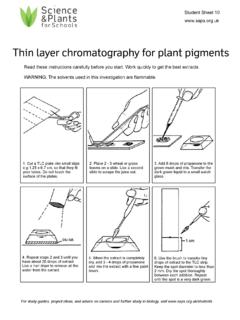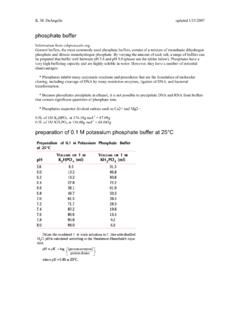Transcription of Cauliflower Cloning - Science and Plants for Schools
1 Student Sheet Cauliflower Cloning You are using aseptic technique in this practical to keep bacteria and fungi from contaminating your Cauliflower . Please follow your teacher's guidance carefully. Safety glasses to be worn at all times. SDICN is toxic and a bleach that removes colour from clothing. Do not inhale the chlorine vapours. Wear protective lab coat and gloves when handling bottles containing the sterilant as caps may leak. Be careful with sharp instruments. SDICN. 1. Place your forceps in a pot of 2. Clean the bench and wipe the 3. Collect a small mini-floret' of sterilising solution (labelled surface with a small amount of Cauliflower and place in a petri SDICN).
2 70% ethanol on a paper towel. dish. SDICN. SDICN. 4. Using a scalpel cut the mini- 5. Use the forceps to pick up your 6. Every 2-3 minutes, swirl the jar floret lengthways into microflorets' explants and put them in a jar of gently for 5 seconds. Repeat until - small 3-5mm pieces. These are SDICN. Put the lid on, and swirl the 15 minutes have passed. your 'explants'. jar for 5 seconds. Put the forceps back in the pot. SD. IC. N. 7. Carefully strain the liquid from 8. Take the lid off the vial of agar 9. Use the forceps to put an the jar into a waste beaker. Use the growth medium. Put the lid face explant into the pot of agar forceps to stop the explants falling down on a clean tile.
3 Try not to lean medium. Press the stalk into the out. Put the forceps in the jar. over your jar on this and the next medium slightly. Replace the lid. step. 10. Use a permanent marker to label the vial with your name and the date. 11. Incubate in a warm lab near to a window or a light bank. Examine each culture weekly. Greening and growth of the explants should be visible within 10 days.
















